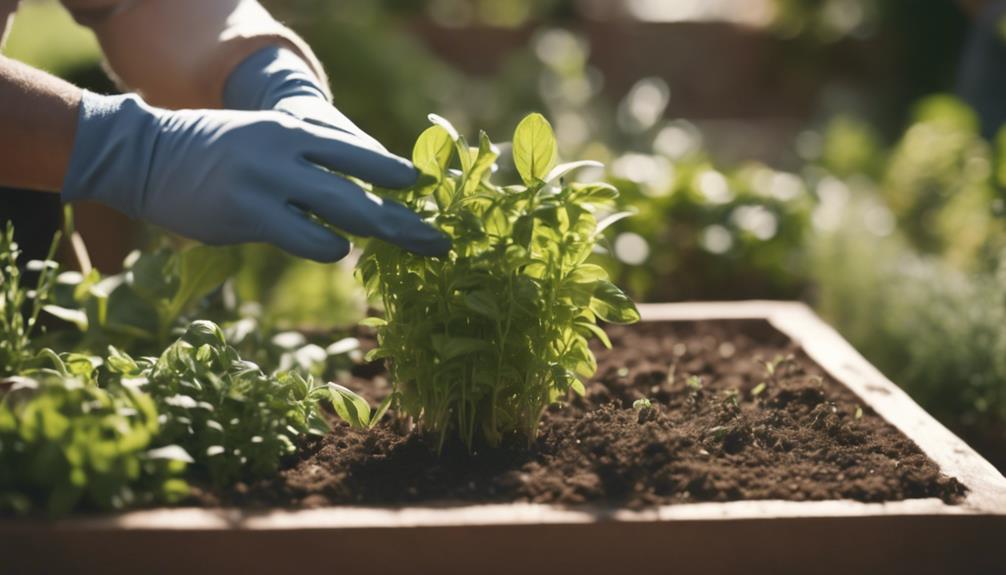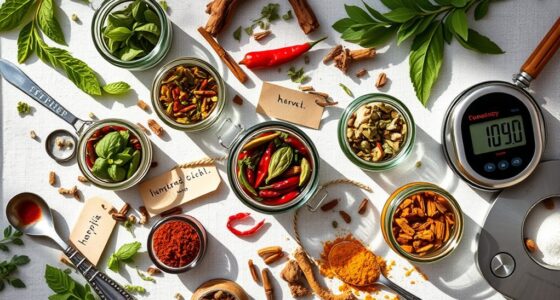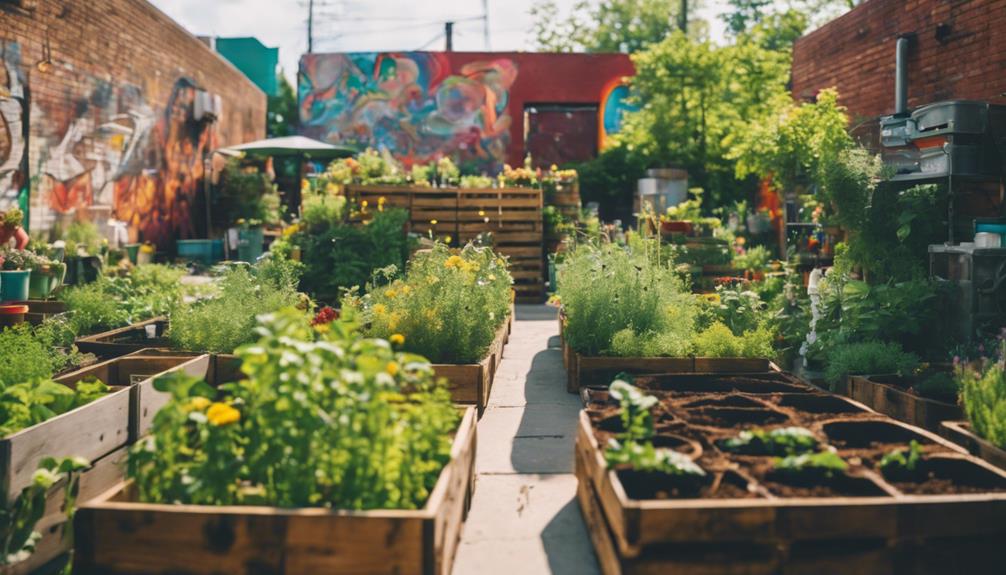Turmeric, garlic, ginger, ginkgo, echinacea, lavender, tea tree oil, grapeseed extract, and chamomile rank as the most potent herbs globally. Turmeric's curcumin fights inflammation and aids heart health. Garlic's allicin battles illnesses and reduces cholesterol levels. Gingerol in ginger soothes inflammation and aids digestion. Ginkgo improves cognition and brain function. Echinacea boosts immunity and offers pain relief. Lavender induces relaxation and enhances sleep quality. Tea tree oil treats skin conditions effectively. Grapeseed extract lowers cholesterol and supports cardiovascular health. Chamomile reduces anxiety and promotes wound healing. Explore further to uncover their full benefits.
Key Takeaways
- Turmeric: Renowned for anti-inflammatory and antioxidant properties, beneficial for arthritis, brain function, heart health, and cancer prevention.
- Garlic: Contains allicin with antimicrobial properties, lowers cholesterol, reduces blood pressure, and enhances overall well-being.
- Ginger: Active compound gingerol lowers inflammation, aids in arthritis, digestive issues, and used in traditional Chinese medicine.
- Ginkgo: Enhances cognition, derived from ancient tree species, offers brain-boosting properties, and potential benefits for various conditions.
- Echinacea: Known for immune-boosting abilities, pain relief, antioxidant effects, and used for cold symptoms; available in various forms.
Turmeric's Potent Health Benefits
With its active compound curcumin renowned for powerful anti-inflammatory and antioxidant properties, turmeric stands out as a herb with significant health benefits.
Turmeric has long been used for arthritis relief, with its anti-inflammatory properties helping to reduce pain and swelling in joints.
Additionally, studies suggest that turmeric can improve brain function by enhancing cognitive abilities and potentially reducing the risk of neurodegenerative diseases.
Its antioxidant properties play an important role in promoting heart health by protecting against damage caused by oxidative stress.
Furthermore, turmeric shows promise in the field of cancer prevention, with research indicating its ability to inhibit the growth of cancer cells and prevent DNA mutations.
Beyond internal health benefits, turmeric's cosmetic applications are gaining popularity for skin rejuvenation in various beauty products.
The herb's brightening effects contribute to its use in cosmetic formulations aimed at enhancing skin radiance and promoting a youthful appearance.
Garlic's Medicinal Properties

Garlic, renowned for its medicinal properties attributed to the compound allicin, has been a staple herb for centuries due to its various therapeutic effects.
Its antimicrobial properties make it a potent herb to combat sickness, including the common cold. Studies have indicated that garlic can effectively reduce total and LDL cholesterol levels by 10-15%, contributing to improved cardiovascular health.
Additionally, regular consumption of garlic has been linked to significant reductions in blood pressure, further solidifying its status as a powerful herb with numerous health benefits.
The therapeutic effects of garlic extend beyond flavoring dishes; they offer a natural way to enhance overall well-being.
With its historical significance and scientifically proven advantages, garlic remains a popular choice for those seeking to incorporate natural remedies into their daily routines. Its multifaceted medicinal properties continue to position garlic as a valuable herb in promoting health and vitality.
Ginger's Anti-Inflammatory Effects

Ginger's active compound, gingerol, is renowned for its powerful anti-inflammatory properties. Traditional Chinese medicine has long valued ginger for its ability to address various types of inflammation. Studies indicate that ginger can lower markers of inflammation in the body, establishing it as a potent natural remedy. The anti-inflammatory effects of ginger have shown promising results in conditions like arthritis and digestive issues. By incorporating ginger into your daily diet, you can proactively combat inflammation and enhance overall well-being.
| Benefits of Ginger's Anti-Inflammatory Effects | |
|---|---|
| Reduces markers of inflammation | Alleviates arthritis symptoms |
| Aids in managing digestive issues | Utilized in traditional Chinese medicine |
Ginkgo's Therapeutic Potential
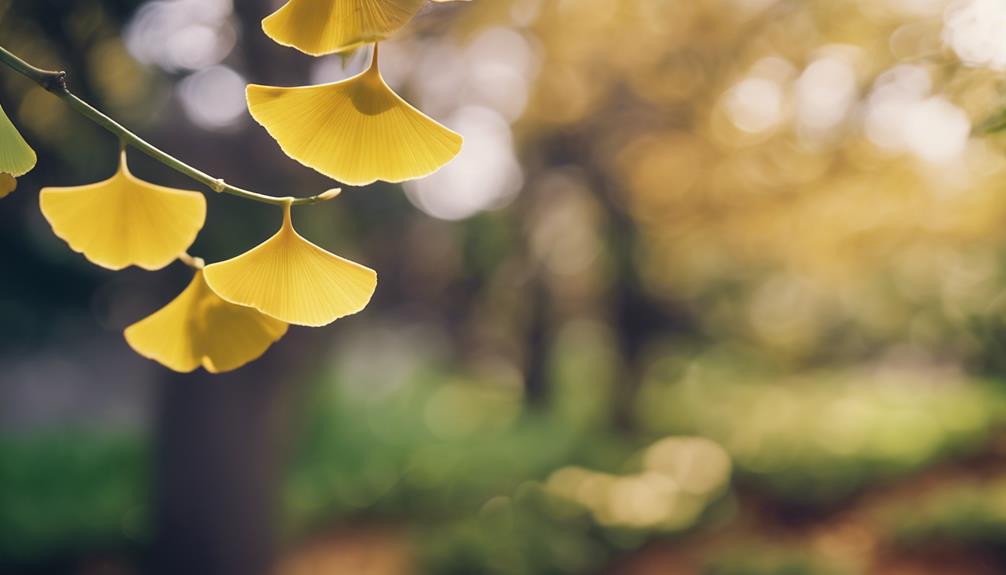
Ginkgo, known for its significant potential in enhancing cognition and treating dementia symptoms, is derived from one of the oldest tree species. The leaves of the ginkgo tree are widely utilized for their brain-boosting properties. Research indicates that ginkgo may provide benefits for various conditions such as diabetes, bronchitis, asthma, chronic fatigue, and tinnitus.
While ginkgo is a commonly used herbal remedy in the US, conclusive evidence supporting its medical benefits is currently limited, necessitating further studies for validation.
It is important to emphasize that ginkgo supplements should only use extracts from the leaves, as the seeds contain a toxin that can trigger seizures. Therefore, when considering ginkgo for its therapeutic potential, it's essential to opt for products that are derived solely from the leaves to avoid any potential risks associated with the seeds.
The multifaceted benefits of ginkgo present a promising avenue for exploring its therapeutic potential in various health conditions.
Echinacea's Immune-Boosting Abilities
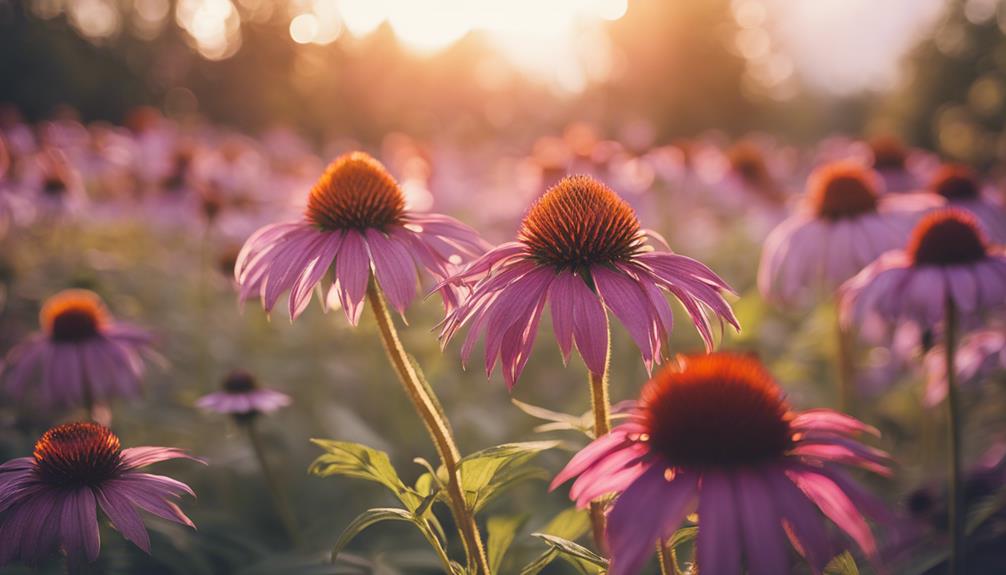
Echinacea is a powerful herb known for its immune-boosting abilities. It has gained popularity for its potential to enhance the body's defenses. Packed with compounds that offer pain relief and antioxidant effects, Echinacea is often used to alleviate symptoms of the common cold.
Available in various forms like capsules and teas, Echinacea has been a go-to option for those seeking natural ways to strengthen their immune system.
Echinacea Boosts Immunity
Boosting immunity is a common goal for many individuals, and one herb that's often turned to for this purpose is echinacea. Echinacea is known for its potential immune support, antioxidant properties, and even mild pain relief effects. It's commonly used as a herbal remedy for cold prevention and general immune system enhancement.
However, while some research suggests echinacea may help in preventing colds, further studies are needed to confirm its immunity-boosting claims definitively. It's important to be aware of potential side effects like stomach upset and digestive issues associated with echinacea use.
Consulting a healthcare provider before incorporating echinacea into your routine is advisable to make sure it's safe for you.
Benefits of Echinacea
When looking to enhance our immune systems, exploring the benefits of echinacea can provide valuable insights into its immune-boosting abilities. Echinacea, a flowering plant from the daisy family, is renowned for its immune-boosting properties. It contains substances that act as antioxidants and offer pain relief. Available in forms such as capsules, tinctures, and teas, echinacea is commonly used for immune support and to prevent colds and flu.
While studies suggest minor benefits in cold prevention, more research is needed to confirm its efficacy fully.
It's essential to note that while generally considered safe, echinacea may cause stomach upset in some individuals. Additionally, it can interact with certain medications, so consulting a healthcare provider before using it's advisable.
Lavender's Healing Properties

Lavender's healing properties encompass a range of benefits, from its calming effects to aiding in sleep and stress relief. The herb's soothing aroma is widely recognized for promoting relaxation and improving sleep quality.
Additionally, using lavender products or essential oils has been linked to reducing stress and anxiety levels.
Lavender's Calming Effects
With its soothing aroma and therapeutic properties, lavender has long been recognized for its calming effects on both the mind and body. This versatile herb, native to the Mediterranean region, is commonly used in personal care products, essential oils, and even culinary creations for its distinct fragrance and potential health benefits.
Here are three key points to highlight lavender's calming effects:
- Relaxation: Lavender is widely praised for its ability to induce relaxation and reduce stress and anxiety. It's often used in aromatherapy to create a calming atmosphere and promote a sense of tranquility.
- Versatile Herb: Beyond its aromatic qualities, lavender is a versatile herb that can be consumed in various forms, including dried herb for teas or cooking, as well as in essential oil form for topical or aromatic applications.
- Health Benefits: Lavender has been the subject of numerous studies exploring its potential health benefits, such as its anti-inflammatory and sleep-enhancing properties, further solidifying its reputation as a powerful herb for overall well-being.
Lavender for Sleep
One can experience the healing properties of lavender through its ability to promote restful sleep and relaxation. Lavender, a powerful herb native to the Mediterranean region, is well-known for its calming effects.
Widely used in personal care products and essential oils, lavender's soothing fragrance has been shown to have potential health benefits, particularly in aiding sleep. The essential oil of lavender can be diffused to create a calming atmosphere, helping individuals unwind and prepare for a peaceful night's rest.
Studies have highlighted lavender's ability to induce relaxation and improve sleep quality. Whether used in aromatherapy or applied directly to the skin, lavender is a versatile herb that offers natural support for those seeking a more tranquil bedtime routine.
Incorporating lavender into your nightly rituals can be a simple yet effective way to enhance your sleep experience and promote overall well-being.
Lavender's Stress Relief
Stress relief is one of the key healing properties associated with the popular herb lavender, renowned for its calming effects and delightful fragrance. Lavender, originating from the Mediterranean region, is a versatile herb widely utilized in personal care products and essential oils.
Here are three essential facts about lavender's stress-relieving capabilities:
- Calming Effects: Lavender is well-known for its ability to promote relaxation and reduce stress levels. Its aromatic scent has a soothing effect on the mind and body, making it a popular choice for aromatherapy and relaxation techniques.
- Health Benefits: Studies have shown that lavender may help alleviate symptoms of anxiety and promote better sleep quality. Its natural compounds have been linked to reducing cortisol levels, the hormone associated with stress.
- Versatile Usage: Whether in the form of dried herbs, powders, or essential oils, lavender can be incorporated into various products like perfumes, shampoos, and creams for its stress-relieving properties, making it a versatile herb for personal wellness routines.
Tea Tree Oil's Antiseptic Benefits
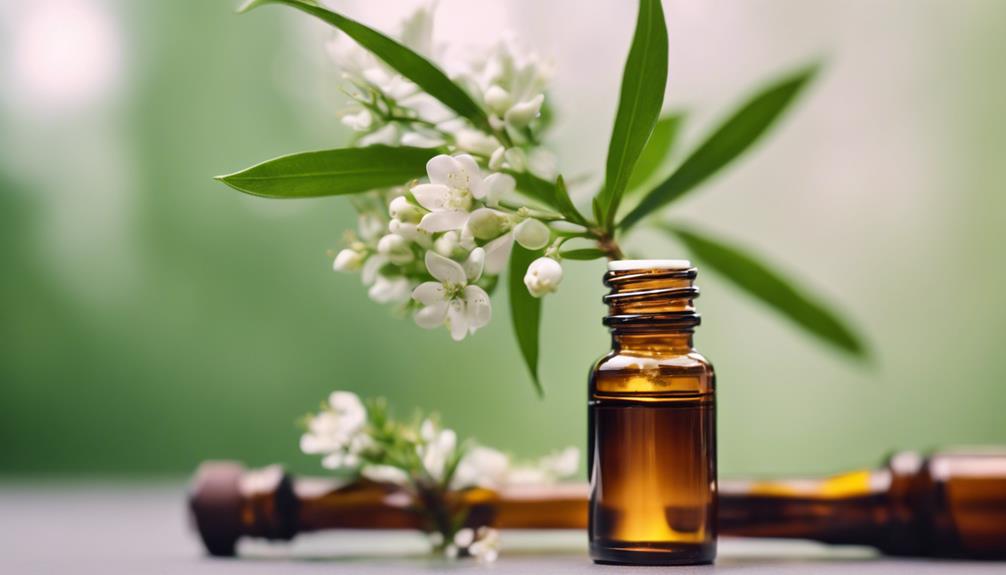
Tea Tree Oil's antiseptic benefits make it a valuable asset in treating various skin conditions and promoting healing. Originating from Australia, this essential oil is renowned for its antimicrobial properties that effectively combat issues like acne, wounds, and dandruff.
With a rich history in traditional medicine, Tea Tree Oil has been widely used for its antiseptic and healing properties, particularly in skincare and wound care practices. Its versatility and effectiveness have made it a popular choice for topical treatments, offering a natural solution for common skin ailments.
Ongoing research continues to explore the full potential of Tea Tree Oil in medical applications due to its potent antiseptic qualities. Derived from the leaves of the Australian Tea Tree, this concentrated essential oil stands out as a potent remedy for a range of skin concerns, highlighting its significance in holistic health practices.
Grapeseed Extract's Antioxidant Power

Grapeseed extract's potent antioxidant properties contribute to its well-established reputation for promoting health and wellness. This herbal supplement is a powerhouse of health benefits, with its ability to lower LDL cholesterol levels and enhance circulation. Research even suggests that grapeseed extract may possess anticancer effects, making it a valuable addition to one's daily routine.
Here are three key points about grapeseed extract's antioxidant power:
- Cholesterol Management: Grapeseed extract has been linked to reducing LDL cholesterol levels, thereby supporting heart health.
- Improved Circulation: The antioxidants in grapeseed extract help improve blood flow, benefiting overall cardiovascular function.
- Potential Anticancer Effects: Studies indicate that the compounds in grapeseed extract may have anticancer properties, making it a promising natural remedy in the fight against cancer.
Whether in liquid, tablets, or capsules, incorporating grapeseed extract into your regimen can offer a range of health-boosting advantages.
Chamomile's Calming Effects
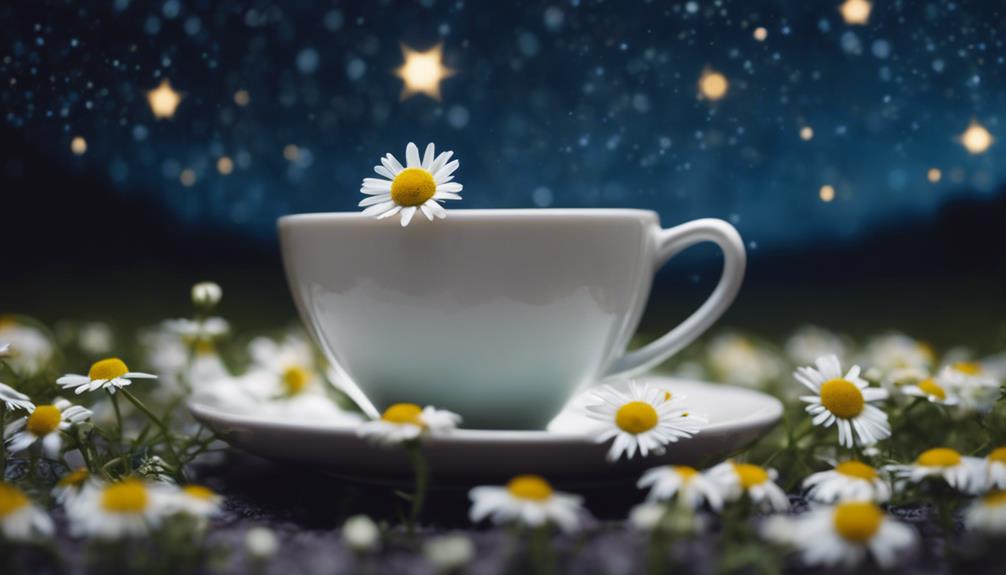
With its origins in Western Europe, India, and Asia, chamomile is revered for its remarkable anti-anxiety properties. Chamomile, available in German and Roman varieties, is well-known for promoting relaxation and reducing anxiety levels. This herb goes beyond calming effects; it aids in wound healing, reduces inflammation, and boasts antioxidant and antimicrobial properties. Chamomile can be brewed into a soothing tea or applied topically for its benefits. However, despite its many advantages, it is essential to note that chamomile may trigger allergic reactions in some individuals. Additionally, caution must be exercised when using chamomile alongside certain medications to avoid potential interactions.
| Chamomile Properties | Effects |
|---|---|
| Anti-anxiety | Promotes relaxation |
| Wound healing | Reduces inflammation |
| Antioxidant | Possesses antimicrobial properties |
| Soothing tea | Potential allergic reactions |
| Topical application | Interactions with medications should be monitored |
Frequently Asked Questions
What Is the Most Power Herb?
When contemplating the most potent herb, recognizing the adaptogenic benefits of Ashwagandha is crucial. This herb, also referred to as Indian ginseng, promotes various aspects of health and wellness, making it a top contender.
What Are the 3 Sacred Herbs?
Ever wondered about the three sacred herbs? Sage, cedar, and sweetgrass hold immense cultural and spiritual significance. We burn them in ceremonies to purify, protect, and bring positive energy. These herbs connect us to traditions and the spiritual domain.
What Is the King of All Herbs?
When it comes to the king of all herbs, Ashwagandha stands out for its adaptogenic properties, stress-reducing effects, cognitive enhancement, and hormone-balancing abilities. Its longstanding reputation in traditional medicine solidifies its status.
What Herb Has the Most Benefits?
When considering herbs with numerous benefits, it is crucial to explore turmeric, ashwagandha, ginseng, garlic, and ginger. These powerful herbs provide a wide range of advantages, from anti-inflammatory and antioxidant effects to stress reduction and immune support.
Conclusion
To sum up, the world of herbal medicine is vast and diverse, with each herb offering unique and powerful health benefits. From turmeric's potent anti-inflammatory properties to lavender's healing effects, these herbs have been used for centuries to promote overall well-being.
With their impressive therapeutic potential, these herbs can be considered the superheroes of the natural world, providing a holistic approach to maintaining health and vitality. Embrace the power of nature and explore the benefits of these remarkable herbs today.


